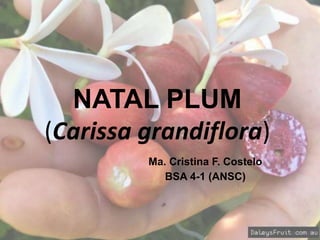Natal plum
- 1. NATAL PLUM (Carissa grandiflora) Ma. Cristina F. Costelo BSA 4-1 (ANSC)
- 2. Natal plum (Carissa grandiflora) •Carissa grandiflora is one of Florida's and California's very best seaside shrubs . •Native to Latin America, the Caribbean and the Southeastern United States •this evergreen is tolerant to a variety of environmental conditions. •This moderately fast-growing, evergreen shrub has lustrous, leathery, rich green, oval leaves and spines along its branches. •Flowers are somewhat fragrant, white, and star-shaped.
- 3. Description • The fruits of the carissa (Carissa grandiflora) are oval or round and vary in size and shape. • A typical fruit is approximately an inch in diameter and one and a half inches long. • The skin of the fully ripe fruit is bright crimson streaked with darker red. • The flesh is deep red or crimson with white mottling. In the center there are approximately twelve small brown flat seeds. • The fresh fruit has a mild, slightly pungent flavor, is slightly granular in texture, and is somewhat astringent. • When bruised, broken, or cut, the fruit and branches exude a white latex. This substance is harmless, except that it may be irritating if it comes in contact withthe eye.
- 4. Natal Plum - Nutritional And Health Benefits • Vitamin C; in fact it has more Vitamin C than in an orange (100 grams of the natal Plum provides 63% of the daily requirement of this vitamin). • has a good amounts of Iron and copper that not only prevents anemia and builds hemoglobin but also prevents weakness and fatigue, depression and dizziness. • good amounts of potassium which regulate blood pressure and improves muscle function. • It contains the heart friendly magnesium and is low in calories.
- 5. Uses Bonsai; foundation; screen; border; mass planting; container or above-ground planter; fruit; espalier; ground cover; superior hedge; parking lot islands
- 6. Propagation • Seeds germinate in 2 weeks but the seedlings grow very slowly at first and are highly variable. • Vegetative propagation is preferred and can be done easily by air-layering, ground-layering, or shield- budding. • Cuttings root poorly unless the tip of a young branchlet is cut half-way through and left attached to the plant for 2 months. After removal and planting in sand, it will root in about 30 days. • Grafting onto seedlings of the karanda (q.v.) has considerably increased fruit yield. • Seedlings may begin to produce fruit in 2 years; cuttings earlier.
- 7. Care and maintenance • The shrubs need afternoon shade in well-drained soil. Avoid growing Carissa shrubs near walkways and outdoor seating, where they can cause injuries with their thick, forked thorns. • keep it away from areas where children play because all parts of the plant, except the fully ripe berries, are poisonous. • Carissa plants are ideal for seaside planting because they shrug off strong winds and tolerate both salty soil and salt spray. This makes them ideal for seaside conditions. • They also perform well in containers on seaside decks and balconies. Upright types are popular as hedge plants, and sprawling types make good ground covers. • Carissa shrubs grow in most any soil, but they prefer sandy sites. • Carissa shrubs need only moderate water and fertilizer.
- 8. Product Utilization jam Jelly Brownies great cordial (left), exotic liqueur (right).
- 9. Refference • http://www.growables.org/information/Tropic alFruit/carissa.htm • http://www.gardeningknowhow.com/orname ntal/shrubs/carissa/growing-carissa- shrubs.htm • http://waynesword.palomar.edu/ecoph20.ht m • http://hubpages.com/health/Natal-Plum-The- Nutritional-Secrets-of-this-Tropical-Fruit

